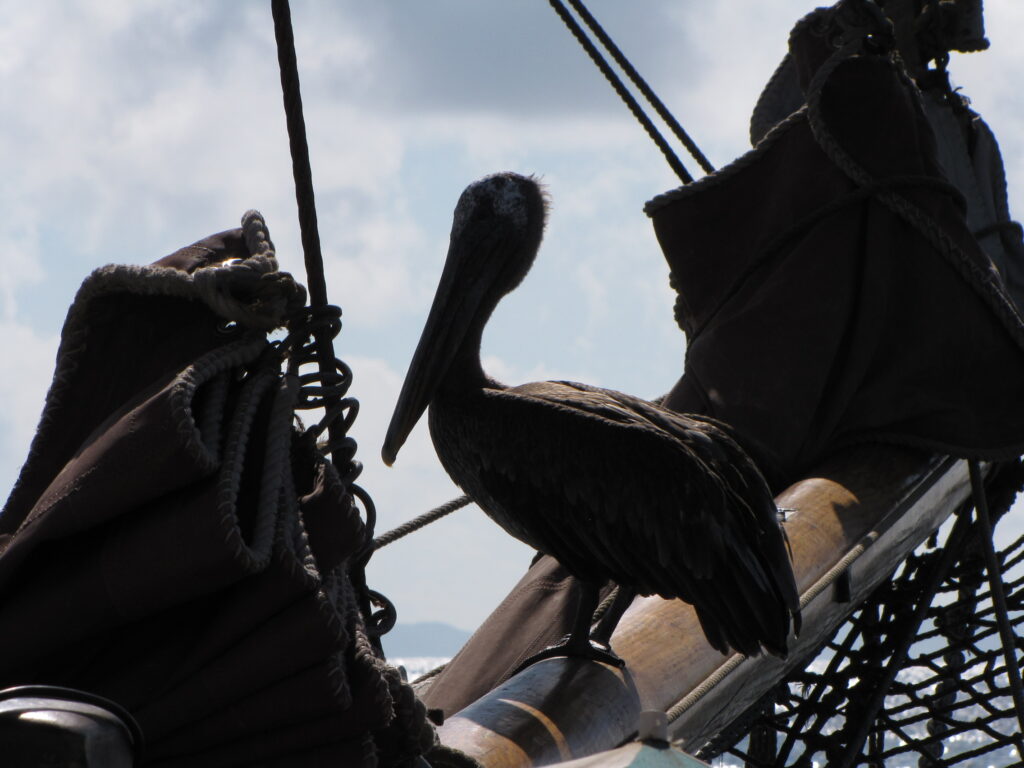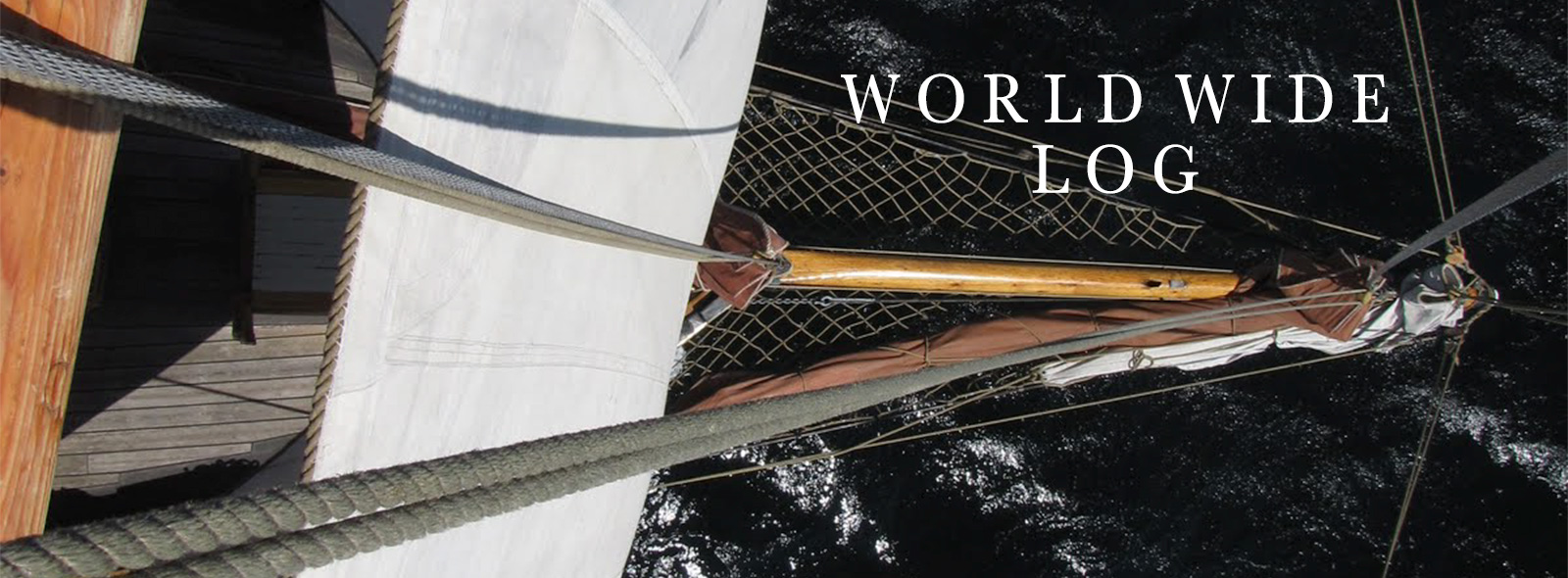
Skippers Log 6: Panama towards Galapagos Islands
Yukon was loaded to the gunwales with provisioning for 40 days, full diesel tanks and 6 new voyage crew. They had already had a few days onboard, to help with provisioning and stowing of the multitude of goodies, that help with a smooth passage.
We bake two loaves of bread every night on the evening watch, this uses around 2 kilos of flour, times that with 40 days and one begins to get an idea, that it’s more than one shopping trolley at the checkout. In fact this time it was around 12 trolleys in all. That’s enough to make any checkout chick roll up her sleeves.
Panama City was a great place to provision with good variety and prices.
Yukon lay on a mooring at the famous Balboa Yacht Club. The club house unfortunately burnt down in the nineties, but in their wisdom, the members built a great open bar and restaurant with all facilities one might need. We enjoyed some good sundowners, whilst watching the constant passing parade of large ships entering or leaving the canal.
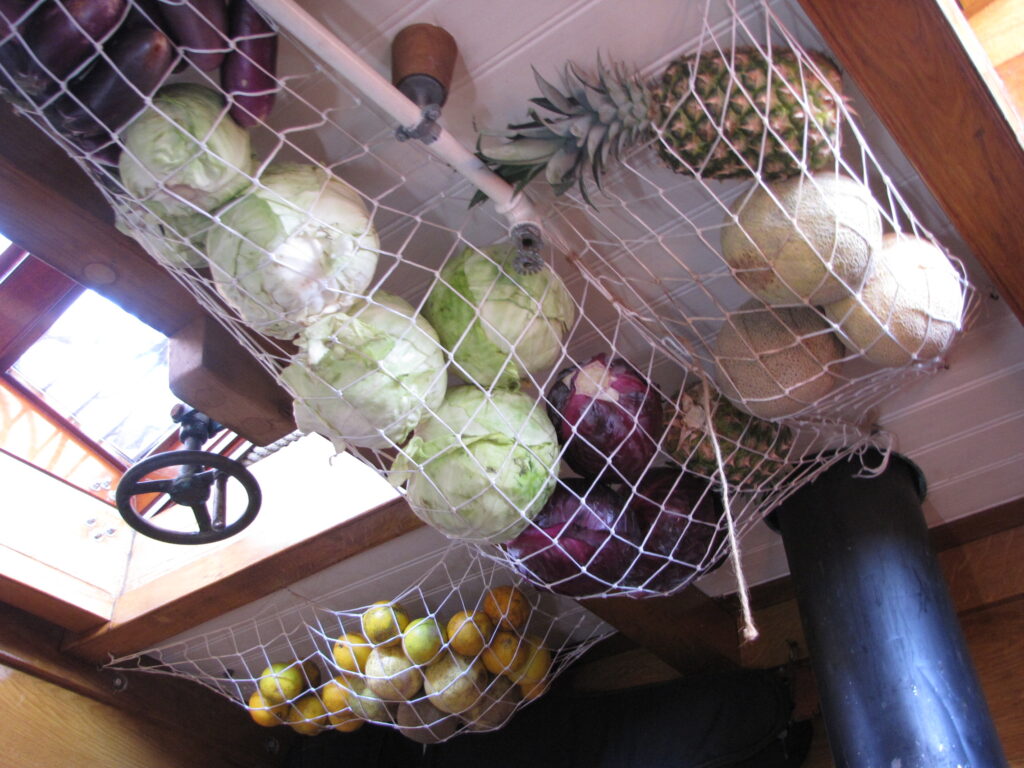
Thursday the 8th of Feburay we clear the main channel out into the Pacific.
We set course toward Las Perlas Islands. This small island group lays about 40 miles south of Panama City and is a convenient first stop on the leg to Galapagos.
We made land fall and anchored up in the lee of Contradora in time for a swim and our evening meal. Night falls quickly in the tropics, so it’s nice to get the dishes done before dark, but failing that we have our trusty genuine Chinese imitation hurricane lanterns to light the way.
The Las Perlas archipelago is made up of about 20 or so islands that are sparsely populated but have some small villages scattered amongst them. They got their name after the Spanish conquistadors who, in the typical style of the day, robbed a large amount of peals from the indigenous King Toe, captured and enslaved his pearl divers.
Today fishing and farming exists on a scale in keeping with the local population, pearls are still available for a good price from the locals.
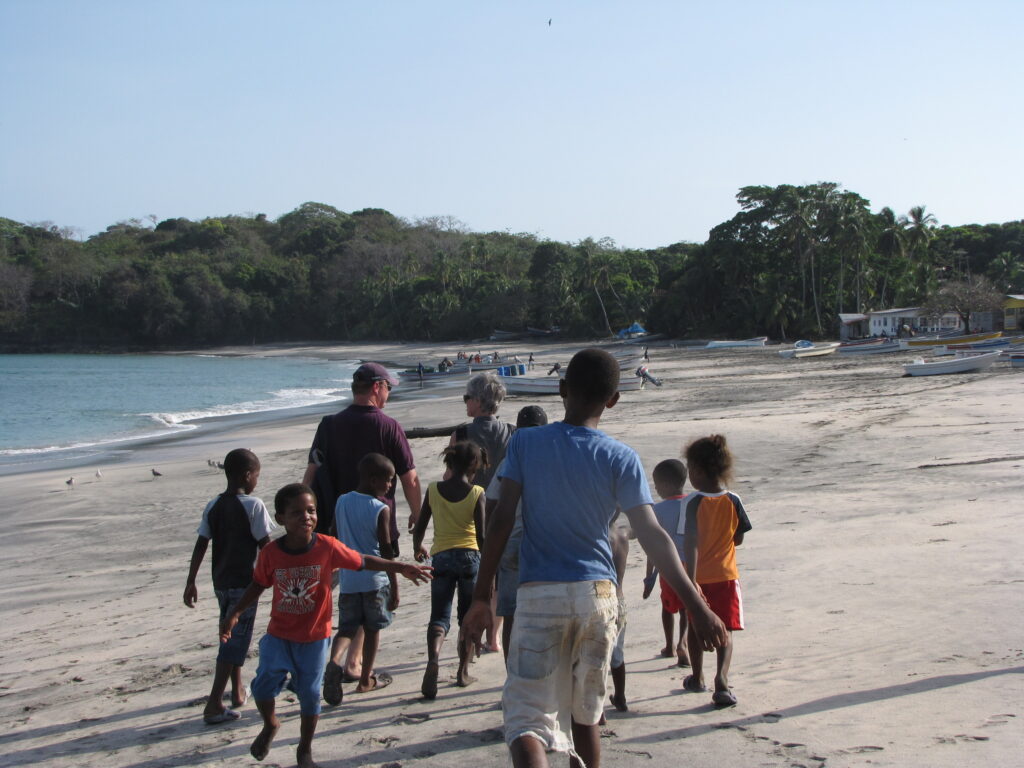
After completing the formalities at Contradora, we set sail early the next morning, but light winds, so typical of this area, made progress slow.
Our goal for the day was to sail only 15 miles south to the neighboring island of Isla Espiritu Santo. A beach barbeque was the plan, and with the help of our trusty main engine Henry, we arrived in good time.
This uninhabited gem of a place boasts a 5 meter tide, so it’s a case of building the fire place high enough up the beach, to stay dry at high water.
Sune was up a Coconut palm to ¨Pick some fruit¨, so we were soon enjoying fresh coconut milk with our sausages. A lovely evening was had by all, it was good to get back out to nature after the hectic days in Panama City.
The next 3 days were taken up with snorkeling and wandering the beaches of this picturesque area, including a stop in a small work camp, concealed behind giant mangroves, where we were invited to eat some lunch.
The locals are friendly and relatively easy going about visitors, the children of the small fishing village of Esmeralda followed us around in their droves, hoping for chocolate or a quarter, they got a bit of both.
We used the last morning to top up our water tanks, making sail around 16.00 on Sunday the 13th of Febuary. Next stop Isla del Coco.
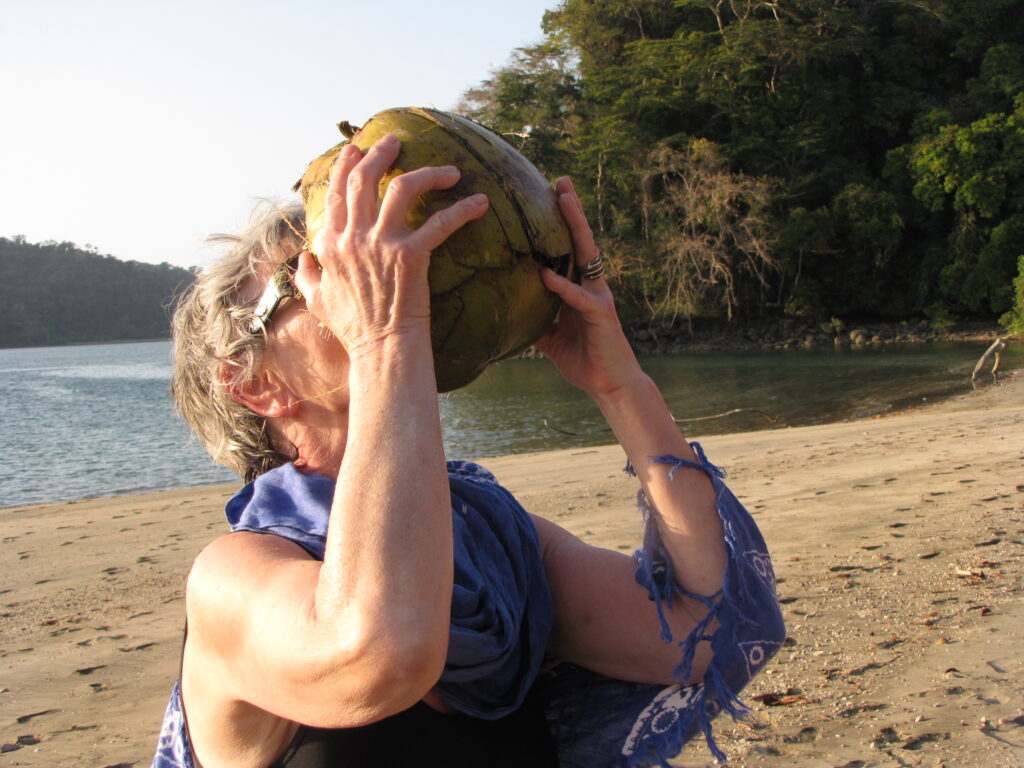
We enjoyed some good sailing, once we cleared the Las Perlas, with a record run of 172 miles on our first day out.
The current of the Gulf of Panama gave us a helping hand down to Cabo Malo, but typically as we put the Central American land mass further and further north of us, the wind died away leaving us in the mirror like seas of the Doldrums.
This broad belt of shallow low pressure centered around the equator, moves north and south seasonally and is typified with calm or light conditions, punctuated by torrential downpours and sometimes heavy wind squalls. It’s a strange cocktail and it’s difficult to know sometimes if one should take a raincoat on or a shirt off, as these tropical downpours approach Yukon. We often altered course a little to pass clear of them, using our radar to track them at night.
Motoring along in these glassy conditions has its charms, with a myriad of stars and planets to entertain us at night, and the hot equatorial sun high overhead by day, it’s a case of find some shade.
The passage of 500 nautical miles was completed in a good time, the last 3 days with motor alone, the log reads ¨Friday 18th Febuary 0700 land ho! Isla Del Coco two points on the port bow. Even after a few days at sea a land fall is always exciting. By midday the same day we had anchored in Chatham Bay on the islands north east corner.
There are some islands in the world that truly stand alone for their unspoiled natural beauty, Isla Del Coco is one of them. Laying 500 miles west of the Gulf of Panama and 400 miles south of its sovereign nation Costa Rica, this uninhabited island lays alone in the eastern Pacific.
Used by Whalers and Pirates for many years because of its abundance of fresh drinking water and shelter from the prying eyes of the world navies and armadas, it was the perfect place to hide all that treasure. Believed to be the model for Robert Louis Stevenson’s famous novel Treasure Island it looks the part with a multitude of grottos and caves dotting its rugged coastline.
Several small anchorages surrounded by thickly forested mountainous terrain, without a building in sight.
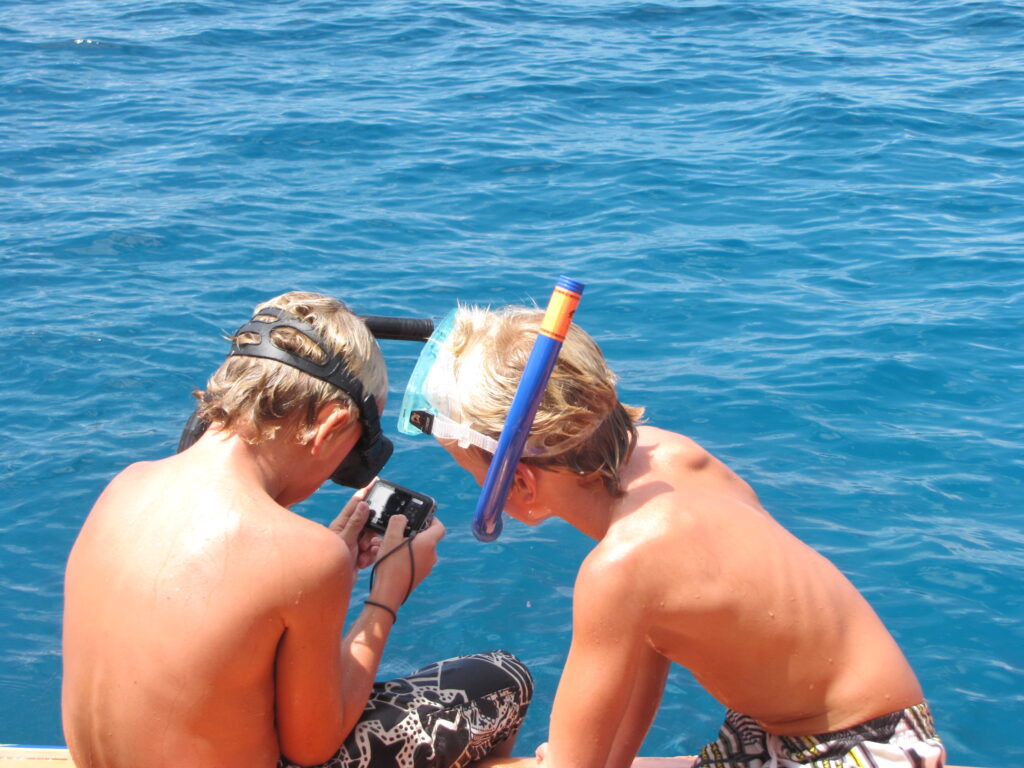
The scene of many an unsuccessful treasure hunt over the years, including one expedition raised by the Costa Rican government in the 1850’s, resulting in the annexing of this natural wonder.
It’s believed that the famous solid gold statue of the Madonna of Calleo, is still stashed away somewhere in the rugged terrain of Cocos’ interior. It makes you think. An average sized woman weighs around 60 kilos, if she was made of solid 24 karat gold we are looking at about 1100 kilos of gold!
The crew and I were a little perplexed on how, we would lift the statue into the dinghy let alone lift her onboard. But we all agreed, that problems are best solved when they become tangible.
The water at the anchorage was amazingly clear and we enjoyed some excellent snorkeling. We could see the bottom in 14 meters of water. A multitude of fish swam in Yukon’s shadow ready to eat any tit-bits like bread crumbs thrown overboard. Reef sharks and hammerheads are prevalent here, they are so well fed so they don’t actually pose a real threat to people. Personally I chose to keep a respectful distance, growing up in South Australia one learns to keep “Noah’s” at a good arms length.
The whole Island and her surrounding waters is a UNESCO world heritage national park. The Costa Rican government has two ranger stations placed in Wafer Bay and Chatham Bay respectively. These Rangers are dedicated to policing the island against would be intruders – as there is no landing strip the only way to get here is by sea.
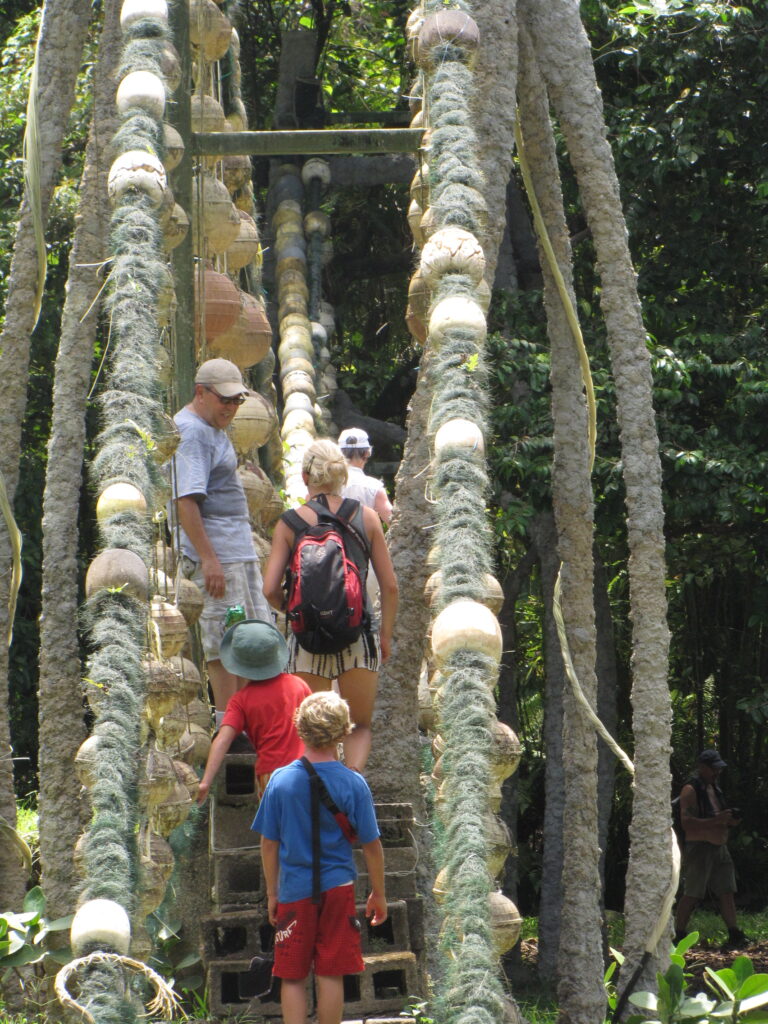
Unlicensed fishing is a big problem. Long liners from China, Japan and Costa Rica ply the local waters and illegally fish. Every day the rangers are out, hauling bales of long line and floats onboard their patrol boats.
This time consuming process is essential in protecting Coco’s unique ecosystem, a shed full of confiscated fishing gear gives evidence to the ruthless exploitation of this island. It also has given these guys something to build with. Around the ranger station guide railings rubbish bins and even a suspension bridge are all constructed of confiscated fishing gear.
We took some great hikes around the immediate area including an hour’s walk up to a lovely waterfall for a swim. In the wet season the island has about 200 waterfalls, they are a sight to behold while cruising her coast, some of them plummeting directly into the sea.
Around the beaches of Chatham Bay the rocks bear testimony to visiting ships over the centuries, names and dates of hundreds of ships are carved into them some as old as 1711 – Henry Morgan and Jacques Cousteau among them.
This is one of those places we didn’t really want to leave, but after 3 nights it was time to shove on.
A fantastic experience, the rangers and volunteers were very friendly and helpful guiding us around this lovely place. To get a glimpse of this fantastic place from the comfort of your own armchair, watch the opening scenes of Spielberg’s Jurassic Park apparently the aerial shots are taken here.
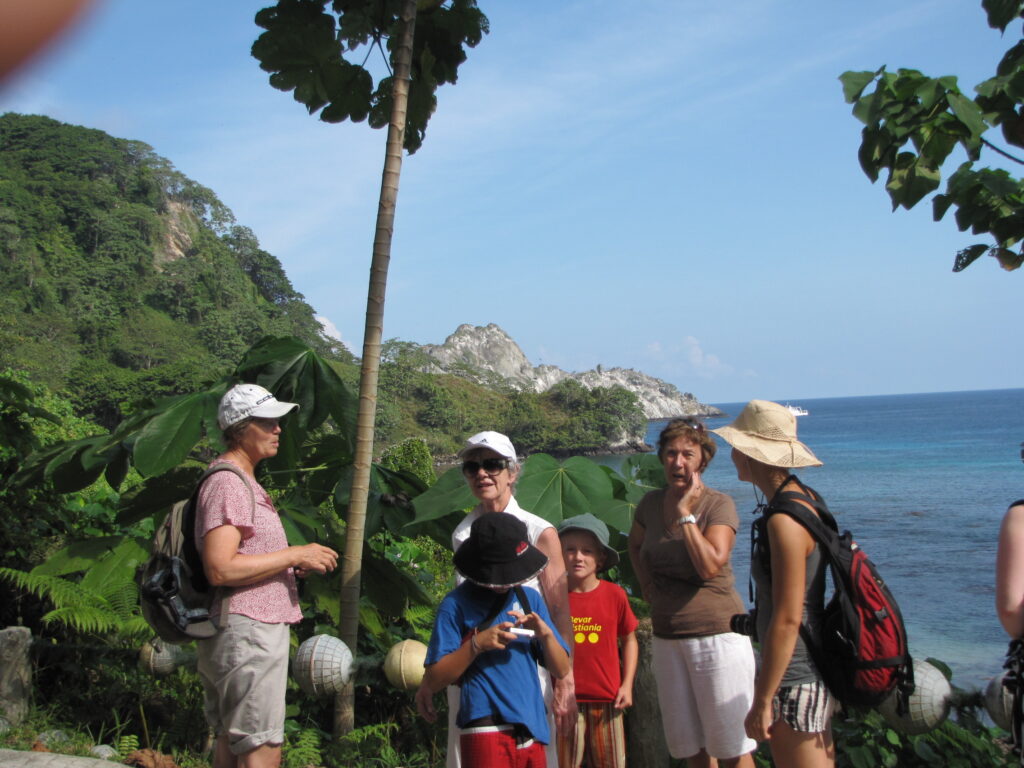
After topping up 500 or so liters of lovely clear fresh water, it was time to slip our mooring and make sail next stop Archipelago De Colon, better known as the Galapagos Islands 500 miles to the south.
We picked a nice easterly, south west of Coco and surprisingly held it for 3 days.
This also gave us a chance to set our new sail a spidser or raffee in English. This triangular sail is set from the deck above our yard on the windward side. It increases our sail area by about 24 square meters and up where it counts. Ola, our Norwegian Boatswain, has used many hours to hand sew this little gem of a sail and it performs admirably. It’s going to come in handy, once we pick up the South easterly trade winds away to the Marquesas.
Motoring is more the rule than exception in this neck of the woods, so any breeze caught is taken as a blessing. We held on to our little share of it until about 100 miles north of the Galapagos, so that eases the fuel bill a bit.
The daily routine on board continued as usual with some swim stops and bath time on the foredeck.
It’s an “La Nina” this year so that means easy weather and very little rain fall as adverse to her brother ”El Nino” which heralds strong winds and unstable conditions.
Amid our daily life on board I detected certain uneasiness amongst some of Yukon’s crew particularly those that had never crossed the line before.
The Equator stretches herself through the Galapagos, so on Friday the 25th of February, King Neptune and his favorite henchman Davy Jones, were aboard to welcome the 9 pollywogs on board to his watery domain. The ritual of initiation and its procedure is secret and its disclosure forbidden.
Two of our voyage crew, Rolf and Karen, had crossed before as had our First mate Sune and myself, so we were number enough to control our ragtag band of renegades, as they were initiated to become Shellbacks and all christened with new names, such as Dolphin, Swordfish or Pilot Whale.
As the evening sun set, we celebrated into the night, the silhouettes of the surrounding islands accompanying us in our joy of having sailed our little ship so far from home, with still so many miles to go.
Time to go and find some big fat Turtles.
More next time.
David “Thomas Ruff” Nash.
